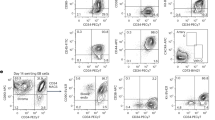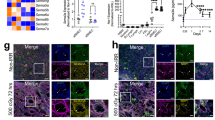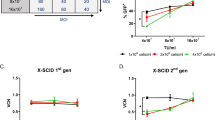Abstract
Angiogenic tumor vessels are promising targets for the activity and the selective delivery of cancer therapeutics1,2. The bone marrow contributes different cell types to the tumor stroma, including hematopoietic cells3,4 and, as recently suggested, vascular endothelial cells (ECs)5. Thus, transplantation of genetically modified bone marrow progenitors may represent a vehicle for the transport of gene therapy to tumors. We transduced bone marrow progenitors with lentiviral vectors expressing genes from transcription-regulatory elements of Tie2/Tek gene6. When tumors were grown in the transplanted mice, the new vector marked a distinct hematopoietic population that 'homed' to the tumor and closely interacted with vascular ECs at the tumor periphery. These Tie2-expressing mononuclear (TEM) cells had a distinguishable phenotype and were present selectively at angiogenic sites. Unexpectedly, we did not find bone marrow–derived ECs in tumor vessels when we transplanted bone marrow progenitors constitutively expressing a marker gene from the Tie2 or ubiquitously active promoters. By delivering a 'suicide' gene, we selectively eliminated the TEM cells and achieved substantial inhibition of angiogenesis and slower tumor growth without systemic toxicity. Thus, TEM cells may account for the proangiogenic activity of bone marrow–derived cells in tumors, may represent a new target for drug development and may provide the means for selective gene delivery and targeted inhibition of tumor angiogenesis.
This is a preview of subscription content, access via your institution
Access options
Subscribe to this journal
Receive 12 print issues and online access
$209.00 per year
only $17.42 per issue
Buy this article
- Purchase on SpringerLink
- Instant access to full article PDF
Prices may be subject to local taxes which are calculated during checkout



Similar content being viewed by others
References
Folkman, J., Hahnfeldt, P. & Hlatky, L. Cancer: looking outside the genome. Nat. Rev. Mol. Cell Biol. 1, 76–79 (2000).
Carmeliet, P. & Jain, R.K. Angiogenesis in cancer and other diseases. Nature 407, 249–257 (2000).
Coussens, L.M. & Werb, Z. Inflammation and cancer. Nature 420, 860–867 (2002).
Mantovani, A., Sozzani, S., Locati, M., Allavena, P. & Sica, A. Macrophage polarization: tumor-associated macrophages as a paradigm for polarized M2 mononuclear phagocytes. Trends Immunol. 23, 549–555 (2002).
Rafii, S., Lyden, D., Benezra, R., Hattori, K. & Heissig, B. Vascular and haematopoietic stem cells: novel targets for anti-angiogenesis therapy? Nat. Rev. Cancer 2, 826–835 (2002).
Jones, N., Iljin, K., Dumont, D.J. & Alitalo, K. Tie receptors: new modulators of angiogenic and lymphangiogenic responses. Nat. Rev. Mol. Cell Biol. 2, 257–267 (2001).
Schlaeger, T.M. et al. Uniform vascular-endothelial-cell-specific gene expression in both embryonic and adult transgenic mice. Proc. Natl. Acad. Sci. USA 94, 3058–3063 (1997).
Follenzi, A., Ailles, L.E., Bakovic, S., Geuna, M. & Naldini, L. Gene transfer by lentiviral vectors is limited by nuclear translocation and rescued by HIV-1 pol sequences. Nat. Genet. 25, 217–222 (2000).
Follenzi, A., Sabatino, G., Lombardo, A., Boccaccio, C. & Naldini, L. Efficient gene delivery and targeted expression to hepatocytes in vivo by improved lentiviral vectors. Hum. Gene Ther. 13, 243–260 (2002).
Motoike, T. et al. Universal GFP reporter for the study of vascular development. Genesis 28, 75–81 (2000).
Okabe, M., Ikawa, M., Kominami, K., Nakanishi, T. & Nishimune, Y. 'Green mice' as a source of ubiquitous green cells. FEBS Lett. 407, 313–319 (1997).
Asahara, T. et al. Bone marrow origin of endothelial progenitor cells responsible for postnatal vasculogenesis in physiological and pathological neovascularization. Circ. Res. 85, 221–228 (1999).
Reyes, M. et al. Origin of endothelial progenitors in human postnatal bone marrow. J. Clin. Invest 109, 337–346 (2002).
Lyden, D. et al. Impaired recruitment of bone-marrow-derived endothelial and hematopoietic precursor cells blocks tumor angiogenesis and growth. Nat. Med. 7, 1194–1201 (2001).
Davidoff, A.M. et al. Bone marrow–derived cells contribute to tumor neovasculature and, when modified to express an angiogenesis inhibitor, can restrict tumor growth in mice. Clin. Cancer Res. 7, 2870–2879 (2001).
Takakura, N. et al. Critical role of the TIE2 endothelial cell receptor in the development of definitive hematopoiesis. Immunity 9, 677–686 (1998).
Takakura, N. et al. A role for hematopoietic stem cells in promoting angiogenesis. Cell 102, 199–209 (2000).
Peters, K.G. et al. Expression of Tie2/Tek in breast tumour vasculature provides a new marker for evaluation of tumour angiogenesis. Br. J. Cancer 77, 51–56 (1998).
Holash, J. et al. Vessel cooption, regression, and growth in tumors mediated by angiopoietins and VEGF. Science 284, 1994–1998 (1999).
Tanaka, S. et al. Tie2 vascular endothelial receptor expression and function in hepatocellular carcinoma. Hepatology 35, 861–867 (2002).
Coussens, L.M., Tinkle, C.L., Hanahan, D. & Werb, Z. MMP-9 supplied by bone marrow–derived cells contributes to skin carcinogenesis. Cell 103, 481–490 (2000).
Luttun, A. et al. Revascularization of ischemic tissues by PlGF treatment, and inhibition of tumor angiogenesis, arthritis and atherosclerosis by anti-Flt1. Nat. Med. 8, 831–840 (2002).
Sawano, A. et al. Flt-1, vascular endothelial growth factor receptor 1, is a novel cell surface marker for the lineage of monocyte-macrophages in humans. Blood 97, 785–791 (2001).
Rafii, S. Circulating endothelial precursors: mystery, reality, and promise. J. Clin. Invest. 105, 17–19 (2000).
Bonini, C. et al. HSV-TK gene transfer into donor lymphocytes for control of allogeneic graft-versus-leukemia. Science 276, 1719–1724 (1997).
Acknowledgements
We thank F. Bussolino, U. Deutsch, C. Bonini and P.L. Lollini for providing reagents; U. Merle for help with partial hepatectomies; L.E. Ailles for help with bone marrow transplantation; G. De Rosa for pathology and A. Sottile for blood cell counts; M. Geuna for help with flow cytometry; L. Sergi Sergi, D. Milne, P. Ferrero, G. Carchia, R. Lonoce and R. Albano for technical help; and L. Trusolino and E.M. Wright for reading the manuscript. C.R. is a recipient of a Fondazione Italiana per la Ricerca sul Cancro fellowship. This research was supported by grants from Associazione Italiana per la Ricerca sul Cancro (23-2001), Telethon (A143), the Italian Ministries of Scientific Research (2002054797) and Health, the European Union (QLK3-1999-00859), Compagnia di San Paolo and Cell Genesys to L.N.
Author information
Authors and Affiliations
Corresponding author
Ethics declarations
Competing interests
The authors declare no competing financial interests.
Rights and permissions
About this article
Cite this article
De Palma, M., Venneri, M., Roca, C. et al. Targeting exogenous genes to tumor angiogenesis by transplantation of genetically modified hematopoietic stem cells. Nat Med 9, 789–795 (2003). https://doi.org/10.1038/nm871
Received:
Accepted:
Published:
Issue Date:
DOI: https://doi.org/10.1038/nm871



